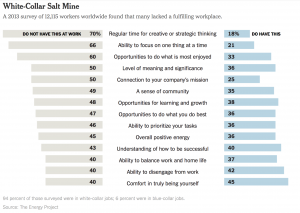Do we really hate work?
A recent article in the New York Times controversially titled “Why you hate work” highlighted the results of a recent study carried out by US Employee Engagement consultancy “The Energy Project” and Harvard Business Review. In the study, carried out in late 2013, more than 12,000 mostly management level employees across a broad range of companies and industries worldwide were interviewed. The study looked at what most influences people’s engagement and productivity at work.
The results can be seen below:
The results supported other similar studies by Gallup that discovered across 142 countries, only 13 percent of employees feel engaged at work. It concluded that “For most of us, in short, work is a depleting, dispiriting experience, and in some obvious ways, it’s getting worse”.
5 ways to improve employee engagement
Looking at the top 5 needs that were highlighted in the survey, we reflect below on what practical steps organisations can take to improve employee engagement in these key areas:
- Regular time for creative or strategic thinking: One of the most regular gripes we hear from clients relates to the quality of management meetings. Most seem to be a one-way download of information with little time for discussion or interaction. Take time to ask your team what they think would be “essential, desirable and nice-to-have” on the agenda at your meetings. You’ll be surprised what they ask for and I bet it’s more time to interact with each other rather than to hear more corporate “cascades”.
- Ability to focus on one thing at a time: As we covered in our recent blog “5 ways to spark life back into your organisation”, senior managers need to filter out the wheat from the chaff and to insulate their teams from fads, short term crises and whims. All too often we see a form of organisational attention deficit disorder as projects are started, suspended, dropped or resurrected. One of my really successful clients uses the idea of “Blue Chips”… the name they give to their most prized projects, the ones they will focus their collective attention on over the coming year. They clear the decks of all other distractions and support their teams to deliver against these.
- Opportunities to do what is most enjoyed: For us, this is about understanding and playing to your employees’ strengths. Often we don’t understand what our employees enjoy doing though as we do not have time for meaningful career conversations with them. As a result, employees are regularly put into roles they are not suited to or motivated by. Career conversations will be a theme for a future guest blog from our associate Antoinette Oglethorpe.
- Level of meaning and significance: As set out by Simon Sinek in his famous Ted Talk “Start with Why”, most organisations focus on connecting employees to the “what” and the “how” of their business and rarely the “why”. Why should your employees come to work and give 100% and why should it matter? Spending some time uncovering the “why” for your organisation and connecting employees to it can have a powerful effect in driving desired behaviours.
- Connection to your [organisation’s] mission: I think there is a big overlap between the last two points above and this area. But connecting employees to the mission can be notoriously difficult from a practical / communications perspective. We have found the organisations that do this well tend to follow some core principles:
- Communicating beyond only data transfer
- Clearing the way for meaningful communication
- Matching words and deeds
- Taking advantage of new technologies
We really hope that as we come out of our recent economic challenges, more organisations start to divert attention to growing not only their bottom line but also their people. We believe they can create truly exceptional and sustainable results if they do this.
If you would like to contact us to bring the love back for your employees, email us at info@flintspark.co.uk.








Leave A Comment